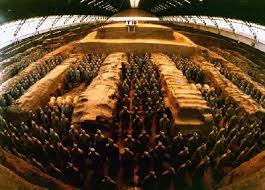
Are the Terracotta Warriors a Wonder of the World?
A Legacy Etched in Clay
Deep within the heart of China's Shaanxi province lies an army frozen in time – the Terracotta Army. Guarding the tomb of Qin Shi Huang, the first emperor of a unified China, these figures stand as a testament to the power and artistry of a bygone era. Their sheer scale and intricate detail have captivated the world, leading many to proclaim them the "Eighth Wonder of the World." But what makes these clay soldiers so extraordinary?
The Silent Guardians of Emperor Qin
The significance of the Terracotta Army goes beyond their visual impact; they offer a glimpse into the ambition and beliefs of ancient China.
-
A Monument to Imperial Might: Commissioned by Emperor Qin Shi Huang in the 3rd century BC, the creation of this army was an undertaking of immense scale. It reflects his desire to command a powerful force even in the afterlife, mirroring the strength and organization of his earthly reign. The sheer number of figures, estimated to be over 8,000, is a testament to the resources and manpower dedicated to this project.
-
An Archaeological Treasure Trove: The discovery of the Terracotta Army in 1974 was a monumental event in archaeological history. Each figure, crafted with meticulous care, provides invaluable insights into the military practices, clothing, hairstyles, and social hierarchy of the Qin Dynasty. They are not merely statues but snapshots of life over two thousand years ago.
Individuality in the Ranks
The most captivating aspect of the Terracotta Army is perhaps the individual character imbued in each figure.
-
Faces of the Past: No two faces in the entire army are identical. Each soldier possesses unique features, expressions, and even hairstyles, suggesting they were modeled after real individuals. This attention to detail brings an uncanny sense of life to the figures, making them more than just representations of soldiers, but individuals frozen in time.
-
Ranks and Roles: The diversity extends beyond facial features. The army is composed of various ranks, from foot soldiers to charioteers, each distinguished by their attire, weapons, and posture. This intricate hierarchy speaks to the sophisticated organization of the Qin army and provides a fascinating glimpse into their military structure.
Conclusion
The Terracotta Army is more than just a collection of statues; it's a testament to the ingenuity, ambition, and artistic prowess of ancient China. Their historical significance, coupled with their sheer scale and breathtaking detail, makes them worthy of the title "Eighth Wonder of the World." The silent army of Emperor Qin continues to stand as a powerful symbol of China's rich cultural heritage, captivating and inspiring generations to come.
Q&A
1. When was the Terracotta Army discovered? The Terracotta Army was discovered in 1974 by farmers digging a well.
2. What is the purpose of the Terracotta Army? The Terracotta Army was created to protect Emperor Qin Shi Huang in the afterlife, reflecting the ancient Chinese belief in an afterlife army.
3. How many figures are estimated to be in the Terracotta Army? It is estimated that there are over 8,000 life-sized figures in the Terracotta Army, including soldiers, chariots, and horses.